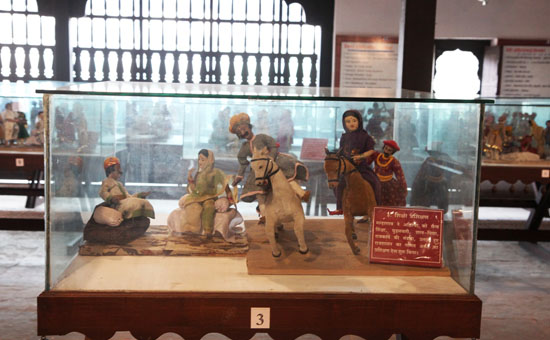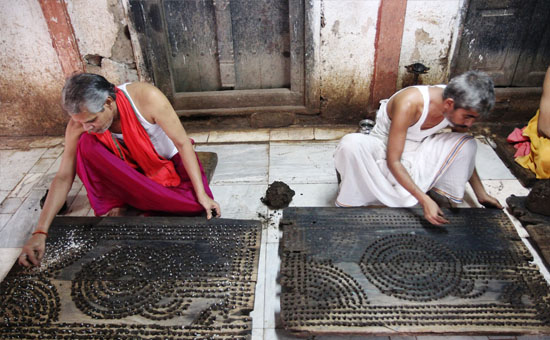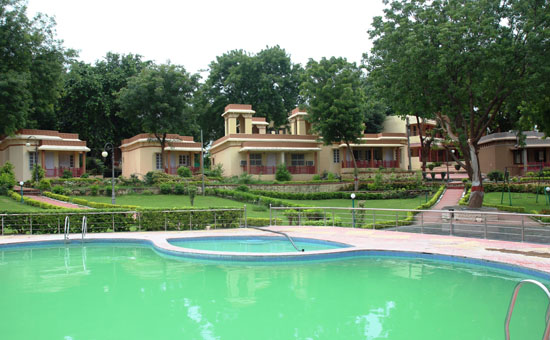When
I visited Kashi got to know that the current Kashi Vishwanath Mandir was made
by Devi Ahilya Bai Holkar of Maheshwar, Madhya Pradesh. Years before that had
seen a Somnath Temple made by her minutes away from where the current temple
stands.
An
earlier article published on eSamskriti told you about the Life Story of
Ahilya Bai Holkar Based on a visit to Rajwada, the erstwhile Holkar Palace in Indore this article gives you a detailed account of Ahilya Bai’s work. She ruled from 1767 to 1795.
Paramhansa Yogananda, author of Autobiography of a Yogi, described Ahilyabai “as the greatest woman of modern India.” Read on to know what prompted Swamiji to make that statement.
This article has six parts. First is a brief background on her life and contributions. Parts 2,3,4 are about projects undertaken by Ahilyabai across India. Part 5 is Lingarchan Puja that was started by her in 1766, to bless the residents of her State, and continues to this day. Lastly, places to see in Maheshwar and suggest
shops from where to buy Maheshwari saris etc.
She
was born in village Chundi, Beed district of Maharashtra. Her father Manokji
Shinde was Patil of the village. Once Malhar Rao Holkar stopped by at Chundi
enroute to Pune and was so impressed by her that he chose her to marry his son
Khande Rao. After her husband died in 1754 Malhar Rao started training
Ahilyabai to be his successor. She had to head the Holkar State after Malhar
Rao and her son Male Rao passed away in 1766.
After assuming charge in December 1767, she dedicated the state to Shankar (Shiva) declaring that she will manage the affairs of the state for the benefit of the people on the behalf of Shankar, herself remaining only a custodian. Her signature, Shree Shankar appeared in all royal proclamations.
She
made Maheshwar the capital of the Holkar State. It is to her credit that during
her 30 year reign Malwa remained stable and peaceful, the Holkar dominions remained
undiminished and not attacked. Ahilya Ma Saheb gave up her body on 13 August
1795.
Ahilya
Bai undertook the task of building & renovating sarais, shelters, temples,
dharamshalas all over the country. All this was done through Khasgi. Khasgi (meant a fund exclusively for Charitable
and welfare activities) had a treasury of its own. It had independent
jurisdiction, in matters of civil and criminal.
She established a Textile weaving industry in Maheshwar. The current generation of Holkars run an NGO, Rehwa Society that has done pioneering work to revive the art. Recently visited their weaving unit in Maheshwar and was very impressed. More about them in a separate article. Importantly Rehwa Society has led the surge in demand for Maheshwari weaving products worldwide. Today thousands of looms exist in and outside Maheshwar providing employment to lakhs esp women.
During Ahilayabai’s regime a trust was set up to ensure independence to the women of the Holkar dynasty so they did not have depend on their male counterparts.
As
part of her policy of unifying the whole country she arranged Gangajaal to be sent every year to 34 shrines
scattered across the country.
She
constructed ghats on the rivers throughout India, built new temples, restored
damaged ones, dug wells, step wells, sumps and also started free kitchen for
the poor and pilgrims.
She not built temples but also paid for the upkeep of learned pandits for contemplation and preaching of scriptures.
Trade
was encouraged and many merchants and farmers flourished. Roads were dug, trees
planted, rest houses set for travellers in order to facilitate travel &
speedy communication.
During
her time Maheshwar became a centre for literature and arts. She patronised many
sculptors, artists and craftsmen who came to work on its buildings and fort.
She
did her charity work methodically. From Badrinath to Kedarnath, and from
Jagannath Puri to Dwarka and Somnath, the imprint of Ahilya Ma Saheb is to be
seen. For the maintenance of these structures a separate fund was created. That
is why even today all her contributions are functional and maintained.
Ahilyabai rebuilt the Kashi Vishwanath Mandir, 118 years after it was demolished by the armies of several Muslim invaders including Aurangzeb in 1669 A.D. Note that Maharaja Ranjit Singh of Punjab donated gold for the temple just like he did for Hari Mandir in Amritsar and Jwalamukhi in Himachal Pradesh.
She contributed to Kailasa Temple Ellora too. “The paintings belong to two different periods, the first one of the period of Rashtrakutas while the second exactly superimposing the original one belong to the period of Holkars when the entire structure was given a lime wash and painted with ochre coloured paintings during the period of Ahilya Bai Holkar.”
By
supporting charities, details of which are below, across the country she
exhibited a national outlook. During a recent visit to Ahilyabai palace in
Maheshwar was touched by its simplicity.
 Ahilyabai being trained. At Rajwada Indore her life presented like this.
Ahilyabai being trained. At Rajwada Indore her life presented like this.
Projects undertaken by Devi Ahilyabai Holkar Part 1
- Mandaleshwar – Shiv Temple Ghat.
- Omkareshwar (MP) – Mamaleshwar Mahadev, Amaleshwar, Trambakeshwar Temple Jirnnodhar, Gauri Somnath Mandir Dharamshalas, Wells.
- Datta Mandir Mangaon – Datta Mandir – near Sawantwadi, Konkan Maharashtra.
- Miri
(Nagar Bhairav Temple 1780).
- Naimabar (MP) – Temple.
- Nandurbar (1) – Temple, Well.
- Neelakantha Mahadev – Shivalaya and Gomukh.
- Nemisharanya (UP) – Mahadev Madi, Nimshar Dharamshala Go-ghat.
- Nimgaon (Nasik) – well.
- Ozar (Nagar) – 2 wells and a kund.
- Panchavati (Nasik) – Shri Ram Temple, Gora Mahadev Temple Dharamshala, Vishweshwar Temple, Ramghat, Dharamshala.
- Parli Vaijnath – Shree Vaidyanath Mandir.
- Pandharpur (Maharashtra) – Shri Ram Temple, Dharamshala.
- Bhanpura – 9 temples and Dharamshala.
- Manasi Devi - 7 Temples.
- Bharatpur - Temple, Dharmashala and Kund.
The question you may ask is, why were so many temples rebuilt and renovated then? With the weakening of the Mughal Empire and ascent of the Maratha, the Hindu community had to undo the damage done by Muslim invasions. Since Marathas dominated India during the 18th century the more enlightened amongst them took on the task of rebuilding. Fyi Malhar Rao Holkar III shifted the capital from Maheshwar to Indore in 1818.
Projects undertaken by Devi Ahilyabai Holkar Part 2
- Kashi – Kashi Vishwanath Mandir, Shri Tarakeshawar, Gautameshwar, many Mahadev temples, Dasashvamedha Ghat, Janana Ghat, Ahilya & Shitala Ghat, Uttar Kashi & Kapila Dhara Dharamshala, Rameshwar Panchkashi Dharamshala.
- Kedarnath – Dharamshala and Kund.
- Karmanshini River Bridge.
- Kurukshetra – Shiv Shantanu Mahadev Mandir, Panchkund & Laxmikund Ghats.
- Kumher – Well and Memorial of Prince Khanderao.
- Maheshwar – hundreds of Temples, Ghats, dharamshalas and houses.
- Madaleshwar Mahadev Himachal Pradesh - Lamps Ghat.
Projects undertaken by Devi Ahilyabai Holkar Part 3
- Gokarn (Karnataka) – Rewaleshwar Mahadev Mandir, Holkar wada, Garden and Garibkhana.
- Gaya (Bihar) Vishnupad Mandir.
- Jagannath Puri Orissa – Shri Ramchandra Temples, Dharamshala and garden.
- Shri
Ganeshwar Mandir, Ellora (Jyotirling).
- Gangotri – Vishwanath, Bhairavnath, Annapurna, Kedarnath temples.
- Chaundi
- Shri Mahadev Mandir & Chaudeshwari Temple.
- Chitrakoot – Pranprathisha of Shri Ramchandra.
- Gruneshwar (Verul) – Shivalaya Tirth.
- Handiya – Siddhanath Temple, ghat and dharamshala.
- Haridwar – Kushawarth Ghat and a huge dharamshala.
- Hrishikesh – Shreenathji and Goverdhanath temples amongst many others.
- Jalgaon – Ram Mandir.
- Jaamghat – Bhumi dwar.
- Jamvagaon – Swami Ramdas math.
- Jejuri – Malhar Gautmeshwar Mandir, Martand Temple, Janai Mahadev and Malhar lakes.
Besides that she also gave donations for Shri Ram Mandir Ayodhya, Shri Chintamani Ganesh Mandir Ujjain, Shri Ram Mandir at Nasik, Sanganer and Pandharpur, Vasudev Mandir Bhusawal, Ganapati Mandir Sultanpur, Laxmi Narayan Mandir Sambalgram, Vishnupad Mandir Prayag. She also gave grants to mosques, Muslim fakirs and saints.
 Lingarchan Puja being formed at Ahilya Fort 2018
Lingarchan Puja being formed at Ahilya Fort 2018
Lingarchan Puja
This
puja was started in 1766 by Ahilyabai and takes places every morning from 8.30
to 9.30 am. This puja was meant to bless the residents of Maheshwar. That time
its population was 1.10 lakhs. Everyday 111 Brahmins each would prepare a board
with 1,000 little shivlings made out of the soil of the fields, each ball
representing one person. These boards would be blessed and the lingams
collected and finally offered in the river Narmada.
The tradition continues 250 years later. The difference being that 11 Brahmins make the shivlings today, each one making 1,100.
Pranams to Ahilyabai Ma Saheb. She peformed her Dharma and was far ahead of her times.
Do visit Maheshwar – is awesome
You can see Ahilyabai Palace, temples on the banks of Ma Narmada, Cenotaph Complex (amazing architecture and reliefs), boating and evening aarti at the Narmada. Visit Rehwa Society for Maheshwar Saris, stoles, shawls and lots more. Missed seeing the Ek Mukhi Datta Temple ie about 5 kms away. Whilst Rehwa Society products are highly reputed locals told me another genuine shop was Hansa Creations. A third good shop is a co-operative in Madhya Pradesh Tourism ka Narmada Resort. Bought from these shops. My wife loves me more now.
I
stayed at the Madhya Tourism Hotel, Narmada
Retreat, at Maheshwar. Loved the place (see pic below). They have a very nice open to the air sitting area on the banks of the Narmada. Spent a couple of hours seeing the river flow – serene and blissful experience. Met a tourist who spent pretty much the whole day reading a book there.
 Narmada Retreat Maheshwar is a great place to stay
Narmada Retreat Maheshwar is a great place to stay
Maheshwar and Omkareshwar, both on the banks of the river Narmada, are worthy of a visit. The temples, the ghats, boating in the Narmada, the serenity- greenery-people and sound of temple bells make them special. One could get spend hours sitting on the ghats at Maheshwar just gazing at Ma Narmada.
Loved Maheshwar. Hope Ahilya Ma Saheb calls me again.
Disclosure: Madhya Pradesh Tourism paid for my stay at Maheshwar.